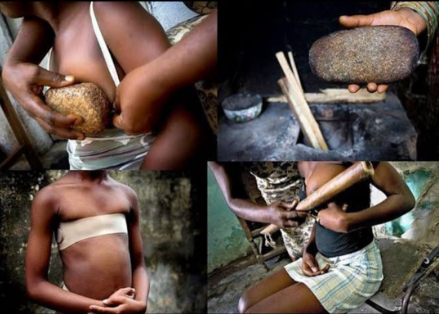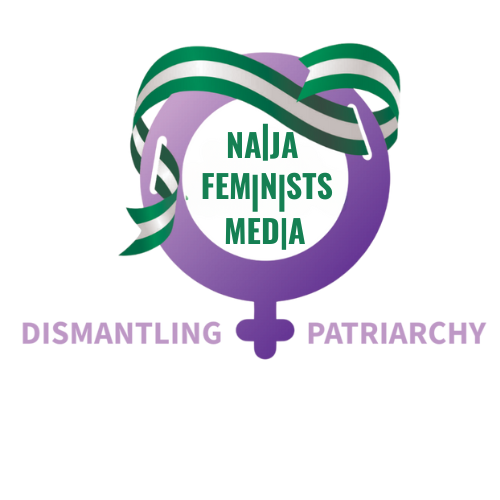|
Getting your Trinity Audio player ready...
|
Summary
Breast ironing is a form of female genital mutilation and one of the identified forms of gender-based violence against girls and women. It is the process whereby young pubescent girls' breasts are ironed, massaged, and /or pounded down through the use of hard or heated objects to delay the development of the breast. The practice harms girls, ironically, so men can not harm them
Majority of people are familiar with femicide, misogyny, gender-based violence, and rape. However, they refuse to imagine the experience of an eleven-year-old girl in the dead of the night at her mother’s kitchen. She screamed for mercy, but her perpetrators turned a deaf ear to her agony. Her mother insisted that her sprouting breasts must be delayed to prevent men’s attraction to her. She believed pounding her daughter’s chest with a heated grinding stone would delay breast formation and prevent unwanted pregnancy.
The girl’s tears did little to save her from the firm hands of her grandmother, who heartily pounded her chest. She sees herself as the saviour of her beloved granddaughter from the prying eyes of male perpetrators. It was done to her just like her mother, grandmother, great-grandmother, and every woman in the household. So, her granddaughter will not be an exception; culture and tradition must be upheld.
Breast ironing is one of the most under-reported crimes of female genital mutilation (FGM) and gender-based violence. It affects 3.8 million women worldwide and is commonly practised in Africa. Breast ironing, also known as breast flattening, is the process whereby young pubescent girls’ breasts are ironed, massaged, and /or pounded down by using hard or heated objects for the breast to disappear or delay the development entirely.
This act is usually performed by the mother or another maternal figure in the household. The origin of breast ironing is untraceable. However, unverified sources claimed breast ironing was practised by lactating mothers who would warm their breasts to produce milk or relieve them of pain. But it is believed breast ironing protect the girl-child from rape harrassment, early marriage, abduction, unwanted preganancy, and make them less attractive to men. Hard objects like hammers, spatulas, large stones, and wooden pestles that have been heated under scorching fire compress the breast tissues of girls as young as nine. Some cultures carry out this practice at 12 for their young girls. The process lasts for four or six months until the budding breast disappears. Breast ironing is practised in African countries like Benin, Ivory Coast, Chad, Guinea-Bissau, Kenya, Togo, Zimbabwe, Nigeria and Guinea-Conakry.
Health implications of breast ironing
Like other harmful cultural practices of Africans, breast ironing has lasting negative implications on the victims. Medically, breasts are made of soft tissue and are usually painful during their development. So, hitting the sprouting bud with scorching hard objects like grinding, large stones, or a pestle causes the victim unbearable pain, and she writhes and screams in pain. Breast ironing causes tissue damage, deformation, abscesses, infection, scarring, burns, cancer, cysts, itching, and a higher risk of cancer.
This traumatic experience also leads to an imbalance of the breast or the complete disappearance of one or both. Suppose the scars from breast ironing are severe, in that case, it affects the development of the breast milk, leading to an inability to lactate after delivery, thus putting the lives of newborn babies at risk. Other health implications of breast ironing include: fibroids, milk discharge when not lactating, production of poisonous breast milk, dissymmetry of the breast, and long-term reproductive complications.
Among the bitter truths, negative health implications of breast ironing are post-traumatic stress disorder (PTSD) and depression. Other mental traumas include fear of breastfeeding, low self-esteem, hatred for any form of sexual activity, psychological distress, inferiority, and hatred for feminine features.
Why breast ironing is a form of FGM and underreported
The firm belief that breast ironing is practised to protect young girls from men is a great problem that makes this barbaric experience underreported. Many mothers who shared this belief will never see its inherent danger or report the incident; rather, they encouraged it. With the belief that breast ironing is an act of love, they provided limited explanation to the victims and claimed that the girl is too young to grow breasts, so it must be suppressed.
Sharing this belief and proof, victims kept silent and endured the agony. Also, this underreported form of FGM is a misguided cultural practice fuelled by myths, fear, and misconceptions. To question it is perceived as a challenge to cultural identity and tradition, defiance, shameful, and a sign of promiscuity. Moreover, breast ironing is more prevalent in rural and hard-to-reach communities where the chances of it being reported are extremely low.
One of the characteristics of FGM is mutilation of the female genitals, and this is in the practice of breast ironing. The breast is distorted, burned, scarred, discoloured, and the victim experienced physical and psychological pain. It is a form of violence and injuring the female genitals that violates their human rights. This harmful practice falls under the Nigerian constitution of the Violence Against Persons (Prohibition) Act, VAPP of 2015, that criminalises all forms of FGM.
Breast ironing is a form of corporal punishment which is prohibited in Nigeria. It is a form of mutilation, illegal, cruel, and inappropriate. Breast ironing is a denial of the dignity and integrity of the victim. It denies girls and women the right to live freely from gender discrimination and violence. Moreover, it is often carried out without the consent of the girl, and it restricts the victim’s right to decision-making about what happens to their bodies, lives, and sexuality.
How breast ironing is a patriarchal belief
To protect girls from men’s prying eyes, mothers and other maternal figures in the family believe breast ironing must be done. Examining this misguided intention provides a clear answer: breast ironing is deeply rooted in patriarchal beliefs. Why should the girl-child be punished because a part of her feminine body is developing? Why does society make the girl-child suffer for men? Why should an eleven-year-old girl experience corporal punishment in the secrecy of the night? Why should the girl-child be ashamed of her breasts and endure childhood trauma? If the mothers still claimed they are doing it for the love of the girl, then the truth must be stated; breast ironing portrays the men as superior, suppressing the girl’s voice and ultimately forcing her to submit to male dominance and power.













